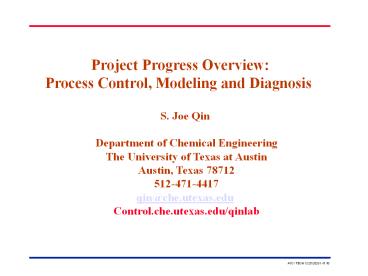Project Progress Overview: - PowerPoint PPT Presentation
Title:
Project Progress Overview:
Description:
Process Control, Modeling and Diagnosis S. Joe Qin Department of Chemical Engineering The University of Texas at Austin Austin, Texas 78712 512-471-4417 – PowerPoint PPT presentation
Number of Views:156
Avg rating:3.0/5.0
Title: Project Progress Overview:
1
Project Progress Overview Process Control,
Modeling and Diagnosis
S. Joe Qin Department of Chemical
Engineering The University of Texas at
Austin Austin, Texas 78712 512-471-4417 qin_at_che.ut
exas.edu Control.che.utexas.edu/qinlab
2
Current Projects
- Chemical process data based monitoring and
control - NSF, DuPont
- Microelectronics process monitoring and control
- NSF, AMD
- Process Fault Detection and Identification
- Texas ARP, DuPont, Union Carbide
- Control Performance Monitoring WeyCo
- Subspace Identification
- DAE/MPC
3
Process Monitoring
4
Data Analysis clusters
- 308 variables
- Process variables
- Setpoints
- Output variables
- Monitoring variables
- Process and monitoring variables were used in
this analysis, 103 variables. - Four clusters
- Red cluster normal
- Blue, green, and black clusters faulty.
5
Hierarchical Monitoring
- Process data is divided in 7 blocks.
- Faulty block is located applying decentralized
monitoring. - Block 2 is where the main fault is located.
6
Contributions in Faulty Blocks
- Using the SPE index the faulty blocks are again
block 2 and block 3. - The variables contributing to the out-of-control
situation in block 2 are mainly variables 16 and
19. - In block 3 mainly variables 25 and 28 are
responsible for the out-of-control situation. - Decentralized monitoring approach gives much
clearer indication of the faulty variables.
7
Block SPE Index
- Block SPE index for all blocks along samples of
data. - Any significant departure from the horizontal
plane is an indication of a fault.
8
Proposed Future Work
- Process monitoring identifies control problems
control performance assessment is interfered by
process disturbances - Process monitoring vs. control performance
- Interrelated
- Elements in a controlled process
- Process, disturbances, faults
- Controllers
- Actuators
- Sensors
- Operators
- All these are to be isolated with the use of data
or a model, requiring an integrated approach
9
Microelectronics
10
Effects of Open Area
- Small open area leads to noisy signal and
hard-to-detect endpoint
11
Final Endpoint Signal
12
Verification of the Detected Endpoint
- Endpoint detection is verified by designed
experiments - SEM pictures also show that vias are cleared
- The thickness correlates well with the etch time
using the endpoint detection algorithm
13
Subspace Identification
14
Subspace Identification
- Represents a new class of methods that produce a
general state space model from process data - The modeling procedure is almost automatic after
the data are collected - Most algorithms work for a wide variety of noise
models, including errors-in-variables (EIV)
models - Deals with input or output collinearity for
coupled inputs or parallel outputs - Optimal/Kalman filtering or estimation is a
natural by-product - Extensions to nonlinear processes are available
in specific model forms - Model adaptation is easy to implement
15
Problem Formulation
Assume the process is represented by
where
Subspace ID Given input output sequencesu(k),
y(k), extract the system matrices A, B, C and D.
16
Summary of Results
- PCA, Dynamic PCA, and Subspace Id. (Li and Qin,
2000) - DPCA by including lagged variables is not
consistent - SMI based IDPCA is consistent for linear dynamics
- SMI model for fault detection (Qin and Li, 2000)
- Need only the observability and Toeplitz matrices
- Maximized sensitivity
- Errors-in-variables SMI using PCA (Wang and Qin,
2000) - PCA with instrumental variables provides
consistent state space models for
errors-in-variables formulation - SMI vs. Kalman Filter vs. PCA vs. CVA vs. PLS???
17
Publications
1. Li, W. and S.J. Qin (2000). Consistent
dynamic PCA based on errors-in-variables subspace
identification. Accepted by J. of Process
Control, July, 2000. 2. Qin, S.J., S.
Valle and M. Piovoso (2000). On unifying
multi-block analysis with application to
decentralized process monitoring. Submitted to J.
Chemometrics. 3. Qin, S. J. and W. Li
(2000). Detection and identification of faulty
sensors in dynamic processes with maximized
sensitivity, Submitted to AIChE Journal.
4. Yue, H. and S.J. Qin (2000).
Reconstruction based fault identification using a
combined index. Submitted to IEC Research.
5. Yue, H., S.J. Qin, J. Wiseman, and A.
Toprac (2000). Plasma etching endpoint detection
using multiple wavelengths for small open-area
wafers. Submitted to J. of Vacuum Science
Technology. 6. Misra, M., S.J. Qin, H. Yue
and C. Ling (2000). Multivariate process
monitoring and fault identification using
multi-scale PCA, Submitted to Comput. Chem.
Engng. 7. Misra, M., Kumar, S., Qin, S.J.,
and Seemann, D. (2000). Error based criterion for
on-line wavelet data compression. Accepted by J.
of Process Control. 8. Li, W., H. Yue, S.
Valle-Cervantes, and Qin, S.J. (2000). Recursive
PCA for adaptive process monitoring. J. of
Process Control, 10, 471 -- 486. 9. H.
Yue, S.J. Qin, R. Markle, C. Nauert, and M. Gatto
(2000). Fault detection of plasma etchers using
optical emission spectra. IEEE Trans. on
Semiconductor Manufacturing, 13, 374-385. 10.
Misra, M., Kumar, S., Qin, S.J., and Seemann, D.
(2000). Recursive on-line data compression and
error analysis using wavelet technology. AIChE
Journal, 46, 119-132. 11. Qin, S.J and R. Dunia
(2000). Determining the number of principal
components for best reconstruction. J. of Process
Control, 10, 245-250.
18
Acknowledging Collaborators
- Modeling/SMI
- D. Di Ruscio, W. Larimore
- Diagnosis
- M. Piovoso, T. Ogunnaike, A. Toprac, C. Ling, J.
Guiver - Pulp and Paper
- T. Swanda, J. Watkins
- Microelectronics
- A. Toprac, R. Markle, H. Yue, M. Misra
- Current Students
- S. Valle, C. McNabb, H. Potrykus, J. Wang, R. Mak
- R. Dunia (post doc associate)































